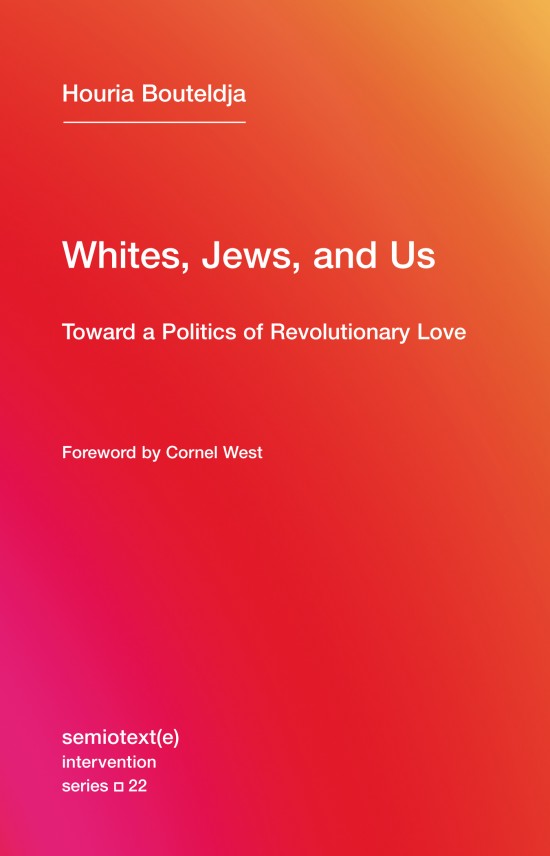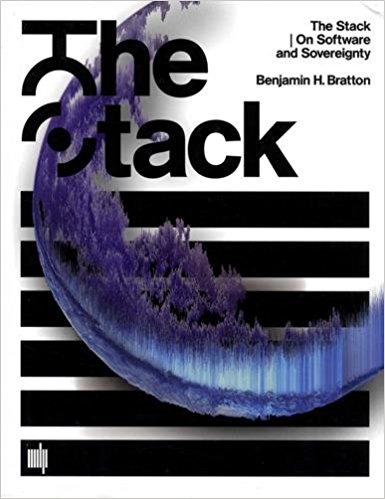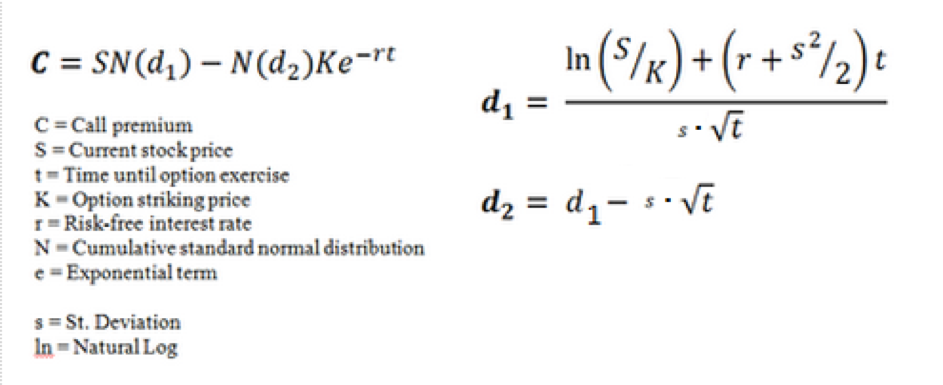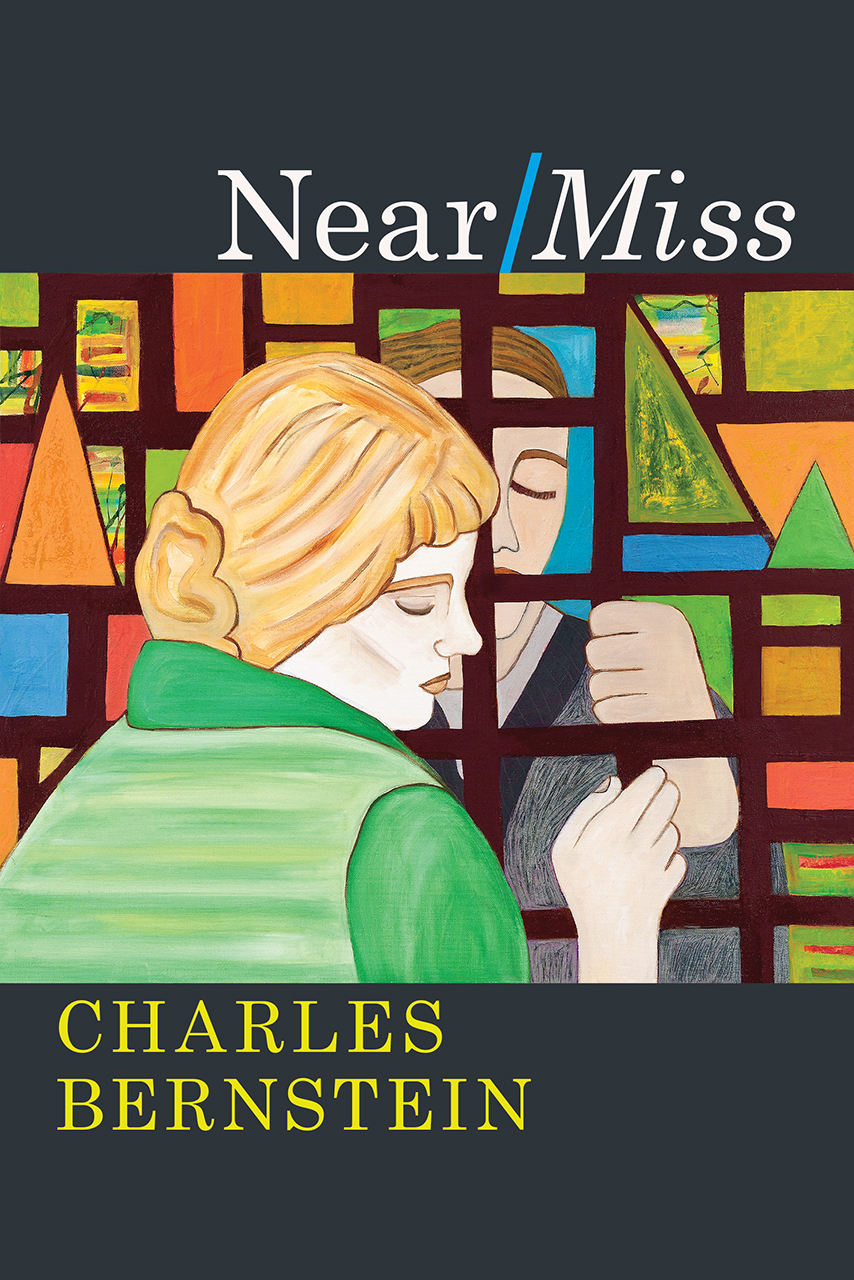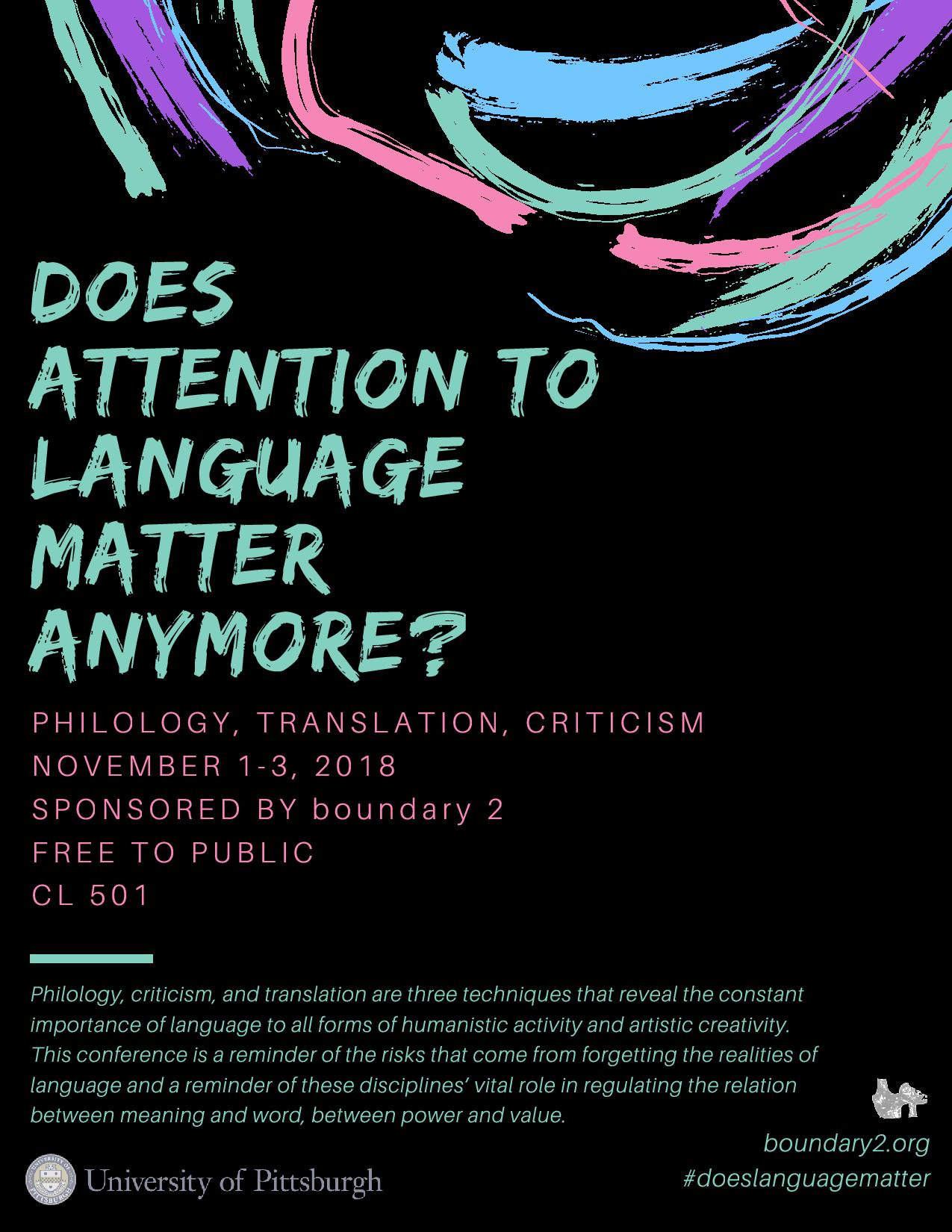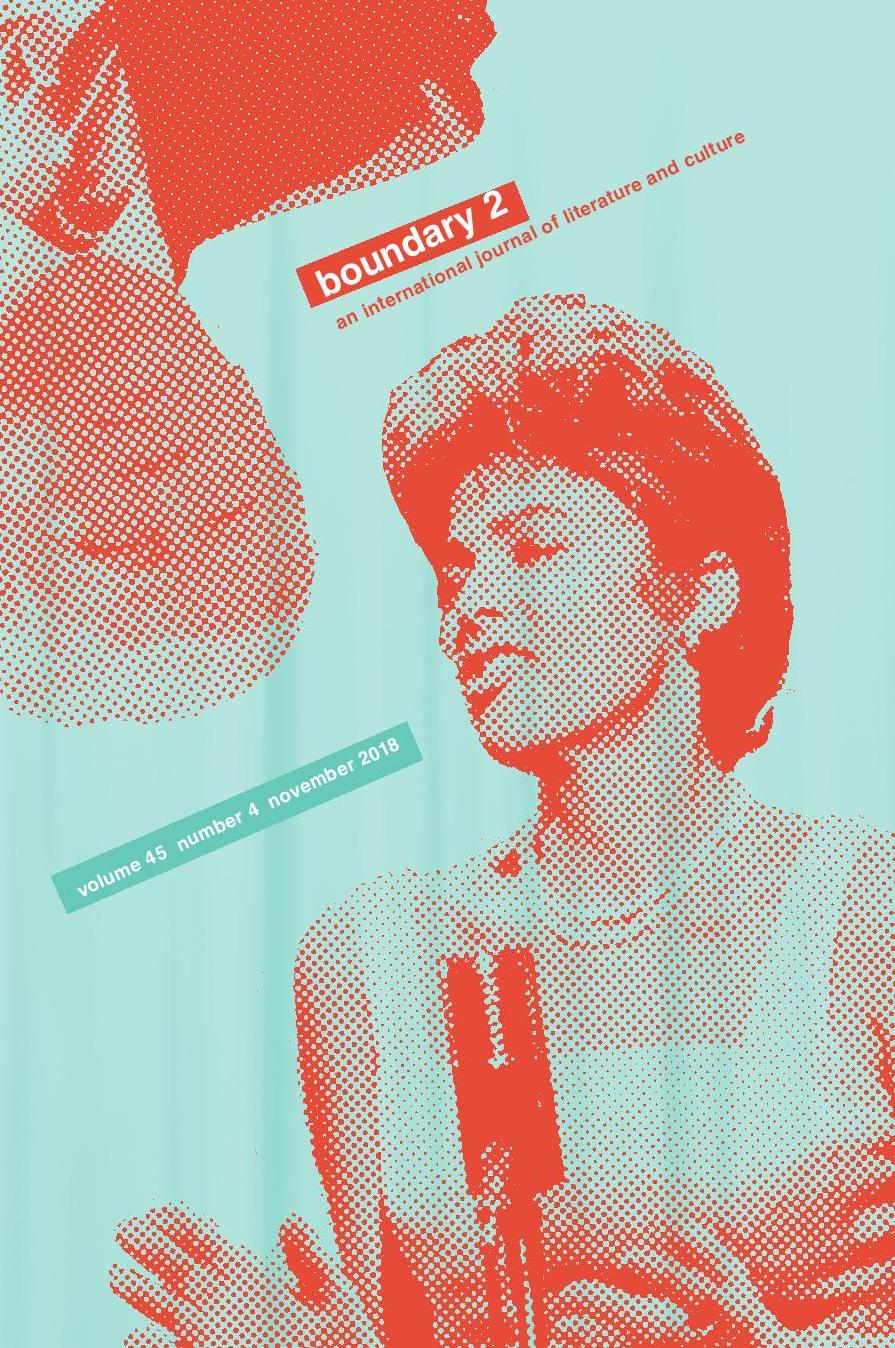a review of Houria Bouteldja, Whites, Jews and Us: Toward a Politics of Revolutionary Love (The MIT Press, 2017)
Revolutionary Love in Dark Times[1]
By Joëlle Marelli
Translated by Jim Cohen
« What counts, when one wants to read a book, is to read the book. »
Rabbi Itzhak Sagmal
1/ In April 2018, the French singer Jacques Higelin passed away. A whole generation of fans has been in mourning. In 1969, he sang, with Areski Belkacem:
J’aurais bien voulu t’écrire / I’d have liked to write you
Une chanson d’amour / A love song
Mais par les temps qui courent / But these days
Ce n’est pas chose commode / It’s not the most convenient thing
It wasn’t convenient in 1969 and it would possibly be even less so today. It may be a love song that speaks to the impossibility of a love song, but above all it’s a quatrain that contains in a single phrase the song and its absence : an enigmatic reference to the era and to the idea that at the present time – or in the time that remains–it’s not possible to write a love song, or that the time might perhaps be better used for something else. However, in 1969, could there have been anything better to do if one was a young singer and poet who would soon become the « crazy singing man » of France’s thirty « Glorious Years » of economic growth, than writing love letters? True, Higelin had already written many love letters a few years earlier,[2] and maybe it was time to move on to other things. Maybe he felt the urge to write for a broader public than the very limited one to which love letters are usually addressed. In any case, beneath the light irony of those lines, a theme appears which places in tension the private temporality of passionate love and the « universal » of belonging to a world that transcends the community of lovers. It seems things were different for Mahmoud Darwish, a poet of the same generation, for whom « writing a poem of love under occupation was both a form of resistance »[3] and something prohibited to him; a form of resistance, thus, to be conquered. In any case, what is fascinating in Higelin’s lines is that they take the form of a trivial excuse (« I would have brought flowers, but the shop was closed », or some other admission of a lover’s inevitable shortcomings), while at the same time pointing to the abysmal inadequacy of the division of labor between private and public.
Since Whites, Jews and Us was published in France (2016), the book and its author, Houria Bouteldja, have been the target of attacks that have often been vicious, sometimes trying to be fair, too often failing in these efforts for being mired in the felt need to attend to prejudices entertained and nourished by mainstream media against what the Indigènes de la République, the political party Bouteldja co-founded, stand for. Any attempt to show that equality doesn’t exist in France causes malicious backlash. Any endeavour to think about race, religion, and gender in terms that vary from the prescribed institutional frameworks (unquestioned brands of universalism and secularism, as well as intrumentalized versions of feminism or opposition to antisemitism ; and an antiracism that is opposed to any input from racialized people, indeed more and more refusing the very category of « racialized people » – « personnes racisées ») is an opportunity for abuse. Most readings – however critical – have failed to make an actual effort to take what the book has to offer. In the best cases, we have seen a recurring theme: « I do not agree with everything she says » – that certain way of conveying an air of sound judgment before expressing a measured agreement. One might ask when one is ever in agreement with « everything » an author writes? The problem is having to provide guarantees of propriety, for Bouteldja as for anyone. The questions will then be : what is a demanding text? What kinds of demands can texts pose for readers? And is it acceptable for subalterns to make demands?[4]
Indeed, it seems to me that Houria Bouteldja could, today, recite or sing, with just as much melancholy and irony as Higelin, or even more : « I would have liked to write you a love song, but these days it’s not the most convenient thing. » The meaning of the words would be somewhat different but no less poignant.
2/ In the most beautiful dialogues of Partage de midi, a play where the dreadful Paul Claudel relates the love and death of white people in the colonies, the severe Mesa asks the indolent Ysé : « What’s that book you’re reading there, which is worn out like a book of love ? » Ysé replies : « A book of love. »[5] Does a lovely scene and some beautiful dialogue, and the author’s rhythmic flair and the fact that the play was written « long ago » (originally in 1906) pardon the abjection of a life’s work shot through, almost completely, with the worst passions of the most bourgeois and reactionary Christianity (moralism, racism, sexism and antisemitism)? This of course did not prevent Claudel’s works from being incorporated without discussion into the French canon and being regularly produced by the most prestigious directors. In any case these lines, too, continue to trot around in our heads each time learned people claim to tell us the meaning of a book written by an indigène[6]. Like Claudel and like any true Christian, even a lapsed one, Mesa is, in principle, a specialist of true love, which is of course not not that of the flesh, as « poor Ysé » believes, leading him to follow her to doom. But he promptly confuses the word and the thing, a book and that of which it speaks (love), and condemns Ysé’s « worn-out » book without having read it. For there are those who know what love is and those who don’t, just as there are those who know what a song (or poem, or book) of love is, and those who don’t. There are those who don’t need to read a book to understand that it needs to be burned and its author denounced – as racist, antisemitic, sexist and homophobic (no less!). And finally there are those who claim to read the book better than the others – « between the lines » – and who tell us what is not in the text and what we were in danger of not seeing. Missing from this list are those who would do for this book what they know how to do for others: give it an actual reading, such that what is transformed is less the book than the reader (« split open the wall of the human heart » – Claudel). They take the risk of being « read » and transformed by the book. We do this with certain books. What are the criteria that cause us to decide not to do it with others?
3/ In 1962, just a few short years before Higelin and Areski sang of the impossibility of writing a love song, Hannah Arendt wrote a few lines to James Baldwin in reponse to his article in the New Yorker entitled « Letter from a Region of My Mind », a text from from which Bouteldja quotes several passages and which ends as follows:
If we—and now I mean the relatively conscious whites and the relatively conscious blacks, who must, like lovers, insist on, or create, the consciousness of the others—do not falter in our duty now, we may be able, handful that we are, to end the racial nightmare, and achieve our country, and change the history of the world. If we do not now dare everything, the fulfillment of that prophecy, re-created from the Bible in song by a slave, is upon us: God gave Noah the rainbow sign, No more water, the fire next time! [7]
Even as Hannah Arendt expresses her overall admiration for Baldwin’s text, she returns – showing her slightly stubborn side that causes us not to « agree with everything she says » – to what she considers to be a mistake: according such an important place to love in the realm of politics:
What frightened me in your essay was the gospel of love which you begin to preach at the end. In politics, love is a stranger, and when it intrudes upon it nothing is being achieved except hypocrisy. All the characteristics you stress in the Negro people: their beauty, their capacity for joy, their warmth, and their humanity, are well-known characteristics of all oppressed people. They grow out of suffering and they are the proudest possession of all pariahs. Unfortunately, they have never survived the hour of liberation by even five minutes. Hatred and love belong together, and they are both destructive; you can afford them only in the private and, as a people, only so long as you are not free.[8]
Something frightened Arendt, although she had seen plenty of other frightful things in her life: the « gospel of love » that Baldwin preaches at the end of his text. Let us reestablish some balance, she seems to say: « Love is foreign to politics. » The positive qualities that Baldwin finds in black people (beauty, aptitude for joy, warmth, humanity) are not only defining traits of oppressed people – or, as Arendt calls them, pariahs – but they are the result of situations of oppression. Freedom (or, better still, emancipation, justice, equality) causes these qualities to disappear; they do not survive for even five minutes. Arendt adopts here the same terms she used in 1959 in her acceptance speech for the Lessing prize in Hamburg,[9] developing a recurring position of hers.[10] Behind the cliché of love being just as destructive as hate, from which is it indissociable (in the work of an author who finds nothing more repugnant than clichés), there is the idea that affects, which pertain to the domain of the particular, cannot be incorporated into the universal sphere of politics. Love and hate are luxuries that « you can afford (…) only in the private and, as a people, only so long as you are not free. » If we shed light on this question from The Origins of Totalitarianism, this disabused attitude constitutes a more elaborate formulation of a theme that is proliferating in its most trivial forms today in France[11] under the effects of an intense preoccupation – more or less subterranean, that is, both conscious and unconconscious – over the past two centuries or more with the inexhaustible question of what makes a group fit or unfit for universalism, that is, for its disappearance as a group:
Since the Greeks, we have known that highly developed political life breeds a deep-rooted suspicion of this private sphere, a deep resentment against the disturbing miracle contained in the fact that each of us is made as he is – single, unique, unchangeable. This whole sphere of the merely given, relegated to private life in civilized society, is a permanent threat to the public sphere, because the public sphere is based on the law of universal difference and differentiation. […] The great danger arising from the existence of people forced to live outside the common world is that they are thrown back, in the midst of civilization, on their natural givenness, on their mere differentiation. They lack the tremendous equalizing of differences which comes from being citizens of some commonwealth and yet, since they are no longer allowed to partake in the human artifice, they begin to belong to the human race in much the same way as animals belong to a specific animal species[12].
It is this singularity, according to Arendt, which calls for love and which is addressed by what she calls love; a singularity which has nothing to do with politics. Worse still:
The danger in the existence of such people [i.e. the « pariahs », those who live outside the « commonwealth »] is twofold : first and more obviously, their ever-increasing numbers threaten our political life, our human artifice, the world which is the result of our common and co-ordinated effort in much the same, perhaps even more terrifying, way as the wild elements of nature once threatened the existence of man-made cities and countrysides.[13]
The conclusion drawn in these passages, as well as other comments by Arendt on the notion of pariah, do not allow us simply to classify her arguments within the historical current which holds that the separation of the spheres is a criterion for sorting out barbarians from civilized peoples:
The danger is that a global, universally interrelated civilization may produce barbarians from its own midst by forcing millions of people into conditions which, despite all appearances, are the conditions of savages.[14]
Though I won’t cease repeating that « I don’t agree with everything she says », clearly here Arendt comes close to playing the role of a seer or prophet in describing our contemporary reality and thus converging with Houria Bouteldja and a few others when they tie the history of postcolonial immigration to France, and the treatment of immigrants and their descendants, to the recent eruptions of delirious ideologies accompanied by upsurges in violent behaviors. In Bouteldja’s words:
We have realized the white prophecy: to become non-beings or barbarians. Our complexities and our nuances have evaporated. We have been diluted, confiscated from ourselves, emptied out of all historical substance. We claim to be what we have been but are nothing but fantasmatic, disarticulated caricatures of ourselves. We cobble together disparate scraps of identity, held in place with bad glue. Our own parents look at us, perplexed. They think, “Who are you ?”[15]
We’ll need to return to this « we » which valiantly refuses to repeat the operation of sorting-out, instead obstinately politicizing, over and against the paradoxical imperative that the pariah extract herself from her condition. This is not the romanticism of an outcast subject, but rather an assuming of the risk and of the Arendtian imperative: every member of a pariah group must choose between being a rebel and being « partly responsible for his own position. »[16] Let us posit for the moment that this « we », fundamentally impure and thus fundamentally political, is in constant construction, and that its corresponding « you » is no less polymorphous and unstable.[17]
The position taken by Hannah Arendt in her letter to Baldwin is in accord with what she famously replied a few months later, on June 23, 1963, to Gershom Scholem, who, after the publication of her Eichmann in Jerusalem, had accused her of lacking « love for the Jewish people » (« ahavat Israel »). Indeed, she retorted, she believed she must reserve the sentiment of love for those close to her, and more precisely for her friends, rather than for ethnic, national, or political groups, or « anything of that sort »: « I indeed love ‘only’ my friends and the only kind of love I know of and believe in is the love of persons. »[18] Such robust common sense is proferred in this context in useful opposition to Scholem’s nationalist and ethnocentric mystique, which in this period, as Amnon Raz-Krakotzkin has shown,[19] represented an abandonment of the lucid and disillusioned analyses of the early years of his residence in Palestine under the British mandate, when, with the Brit Shalom movement, he advocated a form of Zionism compatible with the binational idea. In 1931 he had criticized the alliance Zionism had made with « the manifest force, the aggressor » that is imperialism, forgetting to « link up with the hidden force, the oppressed, which [would] rise and be revealed soon after », by which he was referring to « the revolution of the awakening Orient », a revolution which then seemed imminent and which in his view would force Zionism to choose its camp. This choice could owe nothing to cowardice or opportunism because the danger was equally real, according to Scholem, on both sides of the divide between the imperialist West and the revolutionizing East. Zionism would either be « washed away along with the waters of imperialism » to which it had allied itself at the moment of the Balfour Declaration, « or it [would] be burned in the fire of the revolution of the awakening Orient. » « Mortal dangers beset her on either side, and, nevertheless, the Zionist movement cannot avoid a decision », he continued, only to end on this apocalyptic note:
If it is still possible for an entire movement to change its ways and attempt to join up with the powers that will determine the shape of the coming generation, this I do not know. But I do know that, but for this attempt, it has no other way […] Better that the movement again become small but confident in its ways and pregnant with possibility, than that it remain in its state of disintegration and falsehood and die with the reactionary forces that it followed as a result of the original sin: false victory. And if we do not win once again, and the fire of revolution consumes us, at least we will be among those standing on the right side of the barricades.[20]
By 1963, however – that is, after the catastrophe, as Raz-Krakotzkin points out – Scholem had long abandoned his initial commitment to binationalism and had moved progressively toward the most irresponsible versions of Zionism.[21] Arendt’s reply (« I love only my friends »), which is tantamount to « love has nothing to do with politics », cannot have the same meaning when addressed to Scholem, who claims to justify the censorship of the criticisms of the Judenräte by « love of the Jewish people», as when it is addressed to Baldwin, who calls for whites and blacks to think of each other, together, « as lovers ».
When addressed to the old and reactionary Scholem, Arendt’s reply attests to her freedom and her obstinacy in critical thinking, but when it is delivered to Baldwin, who speaks of « changing the history of the world » (a formula to which she should have been sensitive), her opinion as a specialist of the impossible relationship between private affect and worldly engagement resembles the skeptical frown of a fussy old professor. She does not see that when Baldwin speaks of love and politics, it is in the idiom of another « tradition of the oppressed» – one which has reinterpreted the imperative of love in a manner that could be called Spinozian, that is, turning it into a configuration capable of overpowering the profoundly destructive negativity of affect produced in oppressed subjects by situations of oppression. In The Fire Next Time, Baldwin writes: « I use the word “love” here not merely in the personal sense but as a state of being, or a state of grace – not in the infantile American sense of being made happy but in the tough and universal sense of quest and daring and growth. »[22] » It is not – or is not simply – « Christian » love or « love of one’s neighbor », much less love for one’s enemies.[23] Nor is it about a « demand for love ». As Baldwin further writes: « […] I do not know many Negroes who are eager to be “accepted” by white people, still less to be loved by them; they, the blacks, simply don’t wish to be beaten over the head by the whites every instant of our brief passage on this planet. » [24] The dizzying passage in this sentence from a descriptive « they » to a subjectivizing « we » opens a path for us to understand what he means by « love ». In Just Above My Head Baldwin gives an implacable and terrifying description of the destructiveness of exposure to racism:
It’s a dreadful place to be. I’ve been there a few times since – hope never to go there again. There is a blood-red thunder all around you, a blinding light flashes from time to time, voices roar and cease, roar and cease, you are in the grip of an unknowable agony, it is in your shoulders, your arms, your hands, your breath, an intolerable labor – and, no, it is not at all like approaching an orgasm, an orgasm implying relief, even, sometimes, however desperately, implying the hope of love. Love and death are connected, but not in the place I was that day.[25]
It is to this kind of negativity, which the oppressor seeks to turn into the distinctive sign of the oppressed, and to which the history of oppression seeks to condemn them, that Baldwin accuses Richard Wright of binding black Americans:
To present Bigger as a warning is simply to reinforce the American guilt and fear concerning him, it is most forcefully to limit him to that previously mentioned social arena in which he has no human validity, it is simply to condemn him to death. [26]
Oppression inevitably produces Bigger Thomases,[27] and when they are judged,
It is useless to say to the courtroom in which this heathen sits on trial that he is their responsibility, their creation, and his crimes are theirs ; and that they ought, therefore, to allow him to live, to make articulate to himself behind the walls of prison the meaning of his existence. The meaning of his existence has already been most adequately expressed […] Moreover, the courtroom, judge, jury, witnesses and spectators, recognize immediately that Bigger is their creation and they recognize this not only with hatred and fear and guilt and the resulting fury of self-righteousness but also with that morbid fullness of pride mixed with horror with which one regards the extent and power of one’s wickedness.[28]
But in the time preceding these little ends of the world, these apocalypses within the dimension of a human life, and which prefigure others of greater magnitude, in the time that remains, as we have seen, Baldwin invites « relatively conscious » blacks and whites « to act like lovers », that is, to try to produce more conscience in each other and to persevere in this pursuit without faltering in order to « change the history of the world », failing which the apocalpytic post-Biblical prophecy of the slaves will come to pass: « God gave Noah the rainbow sign, No more water, the fire next time ! »
While the choice posed by Baldwin cannot be understood by the – in this case – stubborn common sense of Hannah Arendt, there is good reason to believe that it would have been heard by Walter Benjamin[29] and no doubt as well, by the Gerschom Scholem of 1931. If one accepts these parallels, then the political love called for by Baldwin is perhaps something like Benjamin’s « real state of exception ». We can call it friendship if we wish, or philia; we may ask to what extent Baldwin’s formulation of revolutionary love would escape Jacques Derrida’s dubious diagnosis in The Politics of Friendship, and wonder how he, Baldwin, would resolve the question – a central one, as Gil Anidjar has shown[30] – about numbers: May I ever embrace, in my friendship or my love, more than a handful of individuals who resemble me? Can these affects, without losing everything that gives them their sensible character, be anything else but elective? One could also consider that the love Baldwin speaks of is a bit like the « proposition » made by C.L.R. James, whom Bouteldja recognizes as a « partisan of revolutionary love » : « These are my ancestors, these are my people. They are yours too if you want them. »[31]. And it must be admitted that there is more love there, without a doubt, but also – to borrow a phrase that has its obscure side and its luminous side – an « offer » that is considerably more « generous » than what is conveyed in apparently symmetrical manner in Nicolas Sarkozy’s phrasing of the « imperative of assimilation »: « As soon as you become French, your ancestors are Gauls. ‘I love France, I learn French history, I live like a French person’ is what each person who becomes French must tell himself/herself »[32]. In Baldwin’s « proposition », and in that of James, and those of Bouteldja[33] there is the proposal for a paradigm change – what Rancière might call a new distribution of the sensible, which presupposes a transformation of the gaze[34] and affective alliances based on new representations of « self », « same », « others » « alike », « neighbour » etc. – that is, a new political subjectification,[35] of a type that immediately creates the conditions for peace[36]. In an article written in 1995, Jacques Rancière relates his reflection on « political subjectification » – and it’s certainly no accident – to his pondering over the impact of the Algerian War on his generation and on the effect it could (should?) have had regarding « the difference internal to citizenship that is the mark of politics » if the forgetting of « internal alterity » had not taken place instead. [37] But these moments and narratives, and the conceptualizations to which they give rise, provide orientation to the living compass that we are, collectively, to ourselves.
Without wishing to speak for Houria Bouteldja, it seems to me that she could say (or could she sing it?) that she would have liked to write a book of love, but that in these times it’s not a convenient thing. It is to « us » that this book appears to be addressed[38] – to us whites, us Jews, us indigenous women, us indigènes – since by the end of the book the reader’s labor of disidentification and (re)subjectification has necessarily begun, that is, if it hadn’t already begun before. It may be to avoid this labor that so many people have brutalized the book and its author. (« What are you reading there, and dissecting – which is not the same as reading – with as much malevolence as a book of love would be dissected by an Inquisition, if the book is about revolutionary rather than « Christian » love (whatever that might be)? « A book of love – revolutionary love. ») Bouteldja aptly quotes Baldwin:
The Negro came to the white man for a roof or for five dollars or for a letter to the judge; the white man came to the Negro for love. But he was not often able to give what he came seeking. The price was too high; he had too much to lose. And the Negro knew this, too. When one knows this about a man, it is impossible for one to hate him, but unless he becomes a man – becomes equal – it is also impossible for one to love him.[39]
Revolutionary love, I hope to have shown, is not the demand for love, nor is it « Christian love », nor loving one’s neighbor nor one’s enemy. It is a disidentifying transformation, a political subjectification that operates at the moment where equality is affirmed. Rancière reminds us that equality is not something that one pursues or obtains but a postulate that becomes actualized through operations made necessary (and are created) for its verification[40]. The performative effect of this postulate and the constant process of its verification on the « supposedly natural logic of domination » is to produce politics. « That means that there is not always politics. It is indeed present quite little and rarely.»[41] That is very different from saying, as Arendt does, that the human group (the Jews in this case–but today it would be the inhabitants of popular districts, or a given category of workers (animal laborans[42])–are « worldless » (weltlos), a privation (Weltlosigkeit, worldlessness) synonymous with a lack of aptitude for politics, of which love, beauty and « anything of that sort », perceived as collective qualities and not reserved to the « private » domain, are the clearest signs. This Weltlosigkeit whose conditions of humanization (or rehumanization?) are the stakes of a tight negotiation with Martin Heidegger, would be known in the French idiom of today, and more trivially, as « communautarisme », that is, the supposed inability or unwillingness of immigrant groups, including generations of their offspring, to assimilate because of their preference for group attachment over universal values and identification with the broader community of citizens. This in turn is why multiculturalism is such a vilified notion in France.
It seems to me that the notion of revolutionary love, as mobilized by Bouteldja (who in turn says she borrowed it, without truly thematizing it, from Chela Sandoval[43]), is one of the possible procedures for the pratical verification of equality. To use Rancière’s terms, it is a « method of equality ».[44] In this process, as it plays out here, equality is verified by a demanding kind of generosity : The Whites, Jews and Us is both a demanding and a generous book. Since when do the subaltern formulate demands? Ever since they have made generous offers, but while also, each time, tirelessly verifying the equality of the relationship; they give the oppressor a chance to dis-identify with the oppressive identity, thus producing a new political subjectification.
One might say – and I will not hesitate to say it, because it’s no doubt the book’s most precious lesson – borrowing and modifying an insight by Hannah Arendt, that every member of a pariah group must not only choose between being a rebel and being « responsible for his/her own oppression »,[45] but must also find the means to escape from the affective negativity engendered by his/her condition. To that end there are only two possible paths: revolutionary violence or revolutionary love. Baldwin reproached Wright for binding African Americans to an imposed negativity. But he also knew, and said so directly, that when the oppressor refuses the generous proposal made by the oppressed (and when has that ever not happened?), it’s the fire next time. Scholem understood that faced with the « fire of revolution », (even when that fire is destined to devour us), one must choose « the right side of the barricades », and not just to save our lives – Scholem was pessimistic in those years but he was clearly not a coward – but in order that, in a way that brings us closer to Kafka, and where we find common ground with Arendt, something other than shame may survive us.[46]
Notes
[1] A short version of this was published on The Immanent Frame, July 12, 2018, under the title « Love in Dark Times », https://tif.ssrc.org/2018/07/12/love-in-dark-times/
[2] Cf. Lettres d’amour d’un soldat de vingt ans (Love letters of a 20 year-old soldier), Grasset, 1987.
[3] Mahmoud Darwish, « Je suis malade d’espoir » (I am sick with hope), interview with Gilles Anquetil, Le Nouvel Observateur n° 2154, August 11, 2008.
[4] Careful observation of what has taken place in France around the book shows that most, if not all the critiques have tended to be rooted not in sound analysis but in what their authors thought they already knew about Bouteldja’s stances, as well as their dismissal of the Parti des Indigènes de la République (PIR : actually a group that started in 2004, with an appeal for the recognition of the colonial roots of the systemic discriminations that affect offsprings of immigrants from former French colonies ; it became a « party » in 2010 – albeit one that never ran for any election).. Much of the literature and thought that have sustained Bouteldja’s thinking, as well as that of other racialized representants of political, as opposed to moral, antiracism (that is, an antiracism that is more interested in pointing to systemic discriminations than in denouncing individual shortcomings) are largely unknown in France : mostly untranslated, but when translated, unread and untaught. This is why and how Bouteldja, the PIR, and other groups and individuals representing racialized minorities, are often attacked for what is interpreted as their subtext, rather than their text.This is also why I have tried to think with the book here, to use it as a toolbox for thinking. I have wondered why no actual conversation has been possible, in France, about it. I have tried to address the book itself (or some aspects of it), rather than the aura of scandalousness around Bouteldja. I have, in short, tried to actually read the book, while leaving aside what I thought I knew about her or about the Indigènes de la République (and I should specify, here, that I was one of the first signatories of the Indigènes’ appeal ; but that I am not part of the PIR). I have to read the book as seriously as I would any other book. This has meant letting the book be inscribed in a network of other writings–one among many possible networks, to be sure. Since that network is made of writings I value, it is a subjective network. Still, it is one that, in my view, is deeply relevant to Bouteldja’s book. As some have shown (Roland Barthes most famously), this subjective networking is what we call reading.
[5] Paul Claudel, Partage de midi, Paris, Gallimard, 1949, coll. Folio, p. 38.
[6] The term indigène (rendered by Bouteldja’s translator as « indigenous ») was used for the first time in the recent French history of postcolonial struggles in a manifesto published in January 2005 under the title « Nous sommes les indigènes de la République » (« We are the indigenous of the Republic »). It refers critically to the status of « natives’ » within the colonial-era French legal system. See Houria Bouteldja, Whites, Jews, and Us. Toward a Politics of Revolutionary Love, translated by Rachel Valinsky, with a foreword by Cornel West, Semiotext(e) intervention series n°22, MIT Press, Cambridge, Mass. and London, England, 2017.
[7] James Baldwin, « Down at the Cross. Letter from a Region in my Mind », in Collected Essays, Literary Classics of the United States, New York, N.Y., 1998, p. 346-7.
[8] http://www.hannaharendt.net/index.php/han/article/view/95/156,
[9] « The humanity of the insulted and injured has never yet survived the hour of liberation by so much as a minute. This does not mean that it is insignificant, for in fact it makes insult and injury endurable; but it does mean that in political terms it is absolutely irrelevant. » Hannah Arendt, “On Humanity in Dark Times: Thoughts about Lessing,” trans. Clara and Richard Winston, Men in Dark Times by Hannah Arendt (New York: Harcourt Brace, 1993) 3-31.
[10] This position can be traced back to the first theoretical elaborations in her biography of Rahel Varnhagen, or even to her thesis on the concept of love in Augustine, and which can be found in different forms in The Jew as Pariah: A Hidden Tradition (1944) and in the first section of The Origins of Totalitaritarianism.
[11] Also in Germany and elsewhere, but nowhere with such candid bonne conscience as in France.
[12] Hannah Arendt, The Origins of Totalitarianism, Harvest Book, Orlando, Austin, New York, San Diego, London, 1976, p. 301-2.
[13] Ibid. 302.
[14] Ibid.
[15] Bouteldja, op. cit., p. 103.
[16] H. Arendt, « The Jew as Pariah : A Hidden Tradition », Jewish Social Studies, vol. 6, No 2 (Apr. 1944), pp 109. The German edition of this essay has « Unterdrückung » (oppression) instead of « position ». Die verborgene Tradition, Suhrkamp Verlag, Frankfurt am Main, 1976, p. 57.
[17] On the central question of dialogue in Houria Bouteldja’s book and elsewhere, and on the manner in which it necessarily causes identity to vacillate, see Gil Anidjar, « Jackals and Arabs (Once More: the German-Jewish Dialogue) », forthcoming.
[18] “Eichmann in Jerusalem: An Exchange of Letters between Gershom Scholem and Hannah Arendt,” Encounter 22, No. 1. January 1964; reprinted in Arendt Hannah, The Jew as Pariah: Jewish Identity and Politics in the Modern Age (Ron. H. Feldman, ed.), New York: Grove Press, 1978, p 246.
[19] Exil et souveraineté. Judaïsme, sionisme et pensée binationale, translated from Hebrew into French by Catherine Neuve-Eglise, Paris, La Fabrique, 2007, p. 170-183; see also « Exile and Binationalism – From Gershom Scholem and Hannah Arendt to Edward Said and Mahmoud Darwish », Carl Heinrich Becker Lecture, Fritz Thyssen Stiftung, 2011 (http://www.eume-berlin.de/en/events/carl-heinrich-becker-lecture/2011-amnon-raz-krakotzkin.html) and « “On the Right Side of the Barricades”, Walter Benjamin, Gershom Scholem, and Zionism », in Comparative Literature 65 :3, University of Oregon, 2013 (https://read.dukeupress.edu/comparative-literature/article-abstract/65/3/363/7798).
[20] Scholem, “Bemai Ka’Mipalgi.” Od Davar. Tel Aviv, Am Oved, 1987. 57–59. Quoted by Amnon Raz-Krakotzkin, in « On the Right Side of the Barricades », art. cit., p. 375-6. I used the French translation of Scholem’s article : « Qui sont les diviseurs ? (1931) », in Le prix d’Israël. Ecrits politiques, Paris, éditions de l’Eclat, 2003. My emphasis.
[21] Amnon Raz-Krakotzkin, art. cit.
[22] Baldwin, « Down at the Cross », op. cit., p. 341.
[23] See Gil Anidjar, The Jew, the Arab, a History of the Enemy, Stanford University Press, 2003.
[24] Baldwin, ibid, p. 299.
[25] James Baldwin, Just Above My Head, Random House, 1979, p. 81.
[26] Baldwin, « Notes of a Native Son », in Collected Essays, op. cit., p. 33.
[27] Main character of the novel by Richard Wright, Native Son (1940), HarperCollins Publishers, NY, 1993.
[28] « Notes of a Native Son », op. cit., p. 33..
[29] « There is no document of culture which is not at the same time a document of barbarism. […]The tradition of the oppressed teaches us that the “state of emergency” in which we live is not the exception but the rule. We must attain to a conception of history that accords with this insight. Then we will clearly see that it is our task to bring about a real state of emergency… » Walter Benjamin, « On the Concept of History », Selected Writings, Volume 4, 1938-1940, Harvard University Press, 2006, p. 392.
[30] Anidjar, The Jew, the Arab, op. cit.
[31] C.L.R. James, The Making of the Caribbean People, » in Spheres of Existence : Selected Writings (London : Allison and Busby, 1980), p. 187 ; quoted by Bouteldja, op. cit., p. 50. In a somewhat different formulation, but not so far removed, see Mahmoud Darwich : « My problem resides in what the Other has decided to see in my identity. Yet I tell him: here is my identity, share it with me, it is broad enough to welcome you. » Mahmoud Darwich, La Palestine comme métaphore, Arles, Actes Sud, 2003, p. 36.
[32] http://www.lefigaro.fr/flash-actu/2016/09/19/97001-20160919FILWWW00356-des-que-l-on-devient-francais-nos-ancetres-sont-gaulois-sarkozy.php
[33] To « whites » : « If things were as they should be, the most conscious among you would be tasked with making us a proposition to avoid the worst. But things are not as they should be. It is incumbent on us to fulfill this task. […] What would be convincing enough to make you give up on defending the racial interests that comfort you out of your downgrading and thanks to which you have the satisfaction of dominating (us)? Other than peace, I don’t know what it would be. By peace, I mean the opposite of « war », of « blood », of « hatred ». I mean: living all together peacefully. » (49) To « the Jews »: « You are still in the ghetto. Why don’t we go out of there together? » (72)
[34] « The distribution of the sensible reveals who can have a share in what is common to the community based on what they do and on the time and space in which this activity is performed. Having a particular ‘occupation’ thereby determines the ability or inability to take charge of what is common to the community; it defines what is visible or not in a common space, endowed with a common language, etc. » Jacques Rancière, The Politics of Aesthetics: The Distribution of the Sensible. Translated with an introduction by Gabriel Rockhill, Continuum International Publishing Group, 2004, p. 12-13. Even while relying on Rancière himself, we may argue that « occupation » is not the only factor determining who has or doesn’t have a share in the community (see « The Cause of the Other », art. cit.). Indeed, so do skin-color, religion, colonial history, etc.
[35] Jacques Rancière, Disagreement. Politics and Philosphy, translated by Julie Rose, University of Minnesota Press, Minneapolis, London, 1999. « Politics is a matter of subjects or, rather, modes of subjectification. By subjectification I mean the production through a series of actions of a body and a capacity for enunciation not previously identifiable within a given field of experience, whose identification is thus part of the reconfiguration of the field of experience. » (35). « Any subjectification is a disidentification, removal from the naturalness of a place, the opening up of a subject space where anyone can be counted since it is the space where those of no account are counted, where a connection is made between having a part and having no part. » (36)
[36] In his Love Letters of a 20 Year-Old Soldier, Higelin tells how, the day Algerian independence was proclaimed, he left the barracks, went out into the streets filled with joy and was immediately recognized as an ally by the Algerians he met: « A teenage boy came toward us, with transfigured traits, incapable of saying a word, overwhelmed with emotion. He shook our hands with passion. He slapped me on the back. […] His look told me : ‘You understand, you came to share, it’s so great!’ »[36] However, it would be pointless to give in to political sentimentalism. In what follows in his correspondence, the young soldier Higelin in Algeria returns quickly to his story of passionate love, not without its narcissistic side, to the detriment of his historical testimony.
[37] Jacques Rancière, « The Cause of the Other » (1998), Parallax 4 :2, p. 32.
[38] Cf. Gil Anidjar, « Jackals and Arabs », forthcoming.
[39] Baldwin, « Letter from a Region of My Mind », op. cit., p. 345. Quoted by Bouteldja, op. cit., p. 51-52.
[40] Rancière, The Ignorant Schoolmaster. Five Lessons in Intellectual Emancipation, translated with an introduction by Kristin Ross, Stanford University Press, 1991, p. 137.
[41] The Disagreement, op. cit., p. 17. The phrase « supposedly natural logic of domination » was not translated from the French in the English language edition of Rancière’s La Mésentente.
[42] H. Arendt, Condition de l’homme moderne, Paris, Calmann-Lévy, 1961 et 1983, p. 147-156.
[43] Chela Sandoval, Methodology of the Oppressed, University of Minnesota Press, 2000.
[44] Rancière, La Méthode de l’égalité. Entretiens avec Laurent Jeanpierre et Dork Zabunyan, Paris, Bayard, 2012.
[45] The Jew as Pariah, op. cit.
[46] See Arendt’s beautiful reading of The Trial: « It has been characteristic of our history-conscious century that its worst crimes have been committed in the name of some kind of necessity or in the name — and this amounts to the same thing — of the “wave of the future.” For people who submit to this, who renounce their freedom and their right of action, even though they may pay the price of death for their delusion, anything more charitable can hardly be said than the words with which Kafka concludes The Trial: “It was as if he meant the shame of it to outlive him. » in « Franz Kafka, a Revaluation », in Essays in Understanding, 1930-1954. Formation, Exile, and Totalitarianism, Jerome Kohn (ed.), Harcourt Brace & Co., 1994, p. 71.
